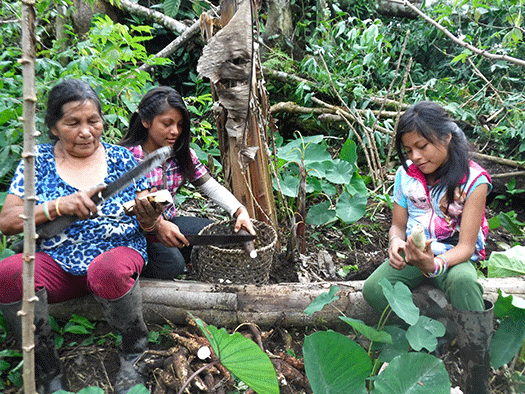“Transmission of Traditional Botanical Knowledge among the Shuar of Amazonian Ecuador,” by Sara Khatib, Tinker Grantee, Department of Anthropology

The purpose of my field season was to receive training in ethnographic research and collect preliminary data on the Shuar of Southeastern Ecuador. Summer 2019 was my first time conducting ethnographic field work, which is why the training aspect from my advisor was important. I learned two basic field methods: participant observation and structured/unstructured interviews. Not only did I learn the technical aspect of these methods, but I also learned the nature of anthropological fieldwork and the need to revise one’s approach as you go.
I practiced participant observation by accompanying women to their fincas (agroforestry gardens). My initial objectives sought to understand how ethnobotanical knowledge is transmitted from one generation to the next. During my trips to the gardens, children almost always were present and worked alongside their mothers and fathers. I did not observe any direct or explicit instructions on the varying tasks. Rather, children seemed to be well informed of how to do the work. Some of these tasks involved harvesting various crops such as camotes, yucas, and even grub beetles. Others involved processing the crop, such as peeling yuca.

Although my initial questions revolved around the transmission of plant knowledge, I was blown away by the complexity of this agricultural system and found myself interested and dedicated to further exploring the Shuar fincas from an agricultural perspective. I have a background in studying alternative agricultural systems, such as permaculture and agroforestry in the United States, and was surprised to find that many tenets of the permaculture movement are being practiced by the Shuar and probably have been for many generations. These tenets include polycropping, minimal waste production, advocating diversity in gardens, minimal weeding, and the balance between subsistence agriculture and community. The Shuar fincas contrasted with nearby mestizo farms which practiced a more conventional form of agriculture, such as mechanization, monocropping, and so on. This field season ignited my interest in studying the various forms of agriculture to compare long-term sustainability, yield production, and economic viability.
In order to gauge if ethnobotanical practice is changing in response to market integration, I administered various types of interviews. I used two free list questionnaires, one to ask participants what plants they grow in their fincas, and another for wild plants harvested from the forest. My sample size was relatively small. The purpose of this research was to pilot the questionnaires, and therefore, much more field work and data are needed before drawing any real conclusions. However, I did come across an interesting component through the initial questionnaires. I discovered that I was not only tracking if people are still using the same plants, but I was also learning how commercialization of certain crops might be affecting the diversity of plants used.
One of the major lessons I took away from this pilot study is the value in holistic methodology. By this I mean using various sources of data to obtain a more in-depth understanding of one’s research questions. For instance, I would not restrict myself to formal participant observations and interviews, but also use stories, archival record, historical markings on the landscape, and varying ontologies in an attempt to gain a more holistic understanding of the Shuar and their relationship with the ecological landscape.
—Sara Khatib was awarded a 2019-20 Tinker Field Research Grant through CLLAS. A second-year graduate student in the Department of Anthropology at the University of Oregon, Khatib has a background in cultural anthropology, paleoethnobotany, and the interwoven relationship between people and the non-human world. She is particularly interested in people-plant relationships. Her research seeks to intersect various frameworks, such as conservation science, political ecology, and indigenous ecological knowledge to provide a more holistic understanding of forest landscapes.
